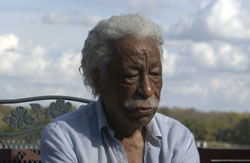 |
→ November 2004 Contents → Column
|
Viewing "The Learning Tree" Helps Kansas Legend Remember His Roots
November 2004
|
|||||||||
|
Fort Scott - Gordon Parks, the author, photographer, poet, musical composer and filmmaker, all rolled into one famous Kansan, came home last week to Fort Scott. He was born there on Nov. 30, 1912, 91 years ago.
"We believe there is much to be learned from his life," the center's director, Jill Warford, said of Parks. "The message he expresses in his work is as relevant today as it was 80 years ago." The four-day festivities included a Queen Bey concert, recollections by Parks' family and friends, lectures, panel discussions and workshops involving films, diversity and the arts. It attracted nearly 300 people and ended Saturday night with a sold-out dinner and "A Tribute to Gordon Parks." Long journey home This was only Parks' second heralded visit to the southeastern Kansas community since 1968, when he was there filming "The Learning Tree." It was the movie version of his classic autobiography about being young and black, growing up in southeast Kansas in the 1920s. "Being back home is difficult to explain," Parks said during an interview Friday. "It's difficult to explain. It's wonderful and it's strange ... brings back all of the good memories and the bad memories together. Last night they all trapped me in bed ... all those memories." Flashing a smile he said, "It's just wonderful to be home. Suddenly I'm out here in this beautiful Kansas day." Ailing and still recovering from recent surgery, the longtime New York City dweller and socialite looked natty in a blue broadcloth shirt, Burberry plaid slacks and hand-sewn loafers without socks. Someone said he was "looking good." "I wish I felt as good as I look," Parks said grinning.
Parks had arrived in Fort Scott on Wednesday and was showing the effects of staying up late after watching a public screening of "The Learning Tree" in a downtown theater. "I've seen that movie in Chicago, New York, Europe ... wherever, but I've never, never appreciated it like I did last night," he said, speaking softly and slowly. "Seeing it in Fort Scott was a very special thing for me, and I felt it deeper than I ever had." In 1989, Parks' first movie effort was one of 25 films chosen by the Library of Congress to be preserved in the National Film Registry. Parks, who dropped out of school when he was 15, credits his mother "for reminding me that I was as good as anyone else" and growing up in Kansas for his determination to succeed. "I got an awful lot of strength here," he said. Photographic mind He was 25 when he bought his first camera for $7.95. Five years later, on a fellowship, he asked to work with the legendary photography staff of the Farm Security Administration. There, shooters like Dorthea Lange, Russ Lee, Andreas Feininger, Arthur Rothstein and Walker Evans were inventing documentary photography. Their assignment: America. "I was told that all of the photographers were white, and only the photo-lab people were black," Parks recalled last week. But Parks persisted, got the job, traveled to Washington, D.C., and met the mind behind the documentary project, Roy Stryker, whom Parks called "tough but fair."
"Well, I was told immediately at Garfinkle's that they didn't carry any suits in my size, I was refused service in the restaurant and they wouldn't sell me a ticket to the movie," Parks said sadly. Stryker was waiting when Parks returned to the office. Parks told Stryker about his lousy day. "He asked me if I thought I could show the country's racism and bigotry with my camera," he recalled. Parks' first example was later titled "Gordon Parks' American Gothic," a photo of Ella Watson, a federal building charwoman posing with a broom and mop in front of an American flag. When Parks showed the photo to his boss, Stryker said, "this will probably get us all fired." Today it ranks as one of Parks' masterpieces. "Hey," he said, smiling at the end of the interview. "If you can make it in Kansas you can make it anywhere."
© Bill Snead
Journal-World Senior Editor For The Digital Journalist
|
|||||||||
Back to November 2004 Contents
|
|


